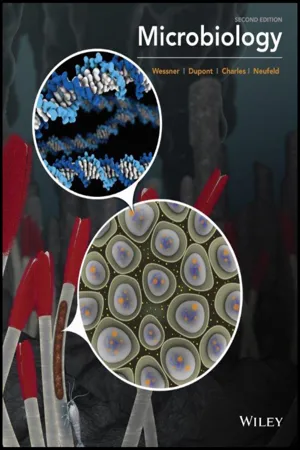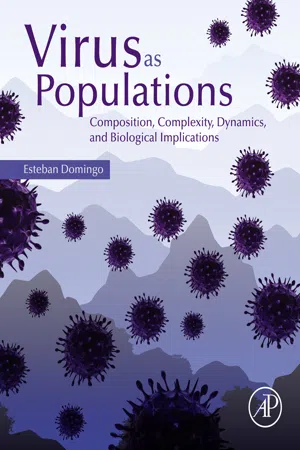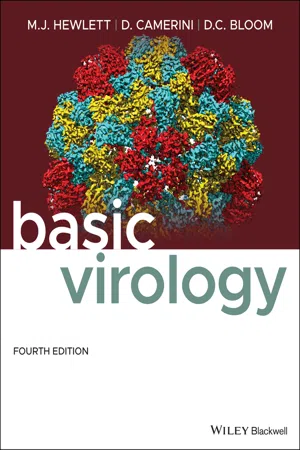Biological Sciences
Viral Replication
Viral replication is the process by which a virus makes copies of itself within a host cell. It involves the virus attaching to the host cell, entering it, and then using the host's cellular machinery to produce new viral particles. This process can lead to the spread of infection within the host organism and to other individuals.
Written by Perlego with AI-assistance
Related key terms
9 Key excerpts on "Viral Replication"
- eBook - ePub
A Guide to Virology for Engineers and Applied Scientists
Epidemiology, Emergency Management, and Optimization
- Megan M. Reynolds, Louis Theodore(Authors)
- 2023(Publication Date)
- Wiley(Publisher)
2016 ),- Attachment (Cell Connection)
- Penetration (Cell Entry)
- Uncoating
- Replication
- Assembly
- Maturation
- Release
These stages are also depicted in Figures 2.1 and 2.2 :Cell Connection and Entry. (Source: https://www.genome.gov/about-genomics/fact-sheets/Genomics-and-Virology .)Figure 2.1Virus Replication and Release. (Source: Adapted from: https://www.genome.gov/about-genomics/fact-sheets/Genomics-and-Virology .)Figure 2.22.2.1 ATTACHMENT (CONNECTION)
Prior to infection, the virion must enter the cell. The first stage is attachment, when the virus uses the host's own surface proteins against it. In the cell's normal functioning, these proteins serve to transport ions and molecules across the phospholipid membrane for use within the cell. The surface proteins often serve as receptors for inbound proteins (Louten 2016 ). The viral surface proteins, or anti‐receptors, mimic those specific proteins the cell would recognize, giving the virus access to the receptor sites for entry (Roizman 1996 ).2.2.2 PENETRATION (ENTRY)
Upon successful attachment, the virus must enter the cell by crossing through the cell plasma membrane. This could occur in a few ways, including:- Entry by Direct Fusion This method is available only to enveloped viruses, where the envelope fuses directly with the membrane, leaving the virus within the cell wall without its envelope, but with its capsid intact.
- Receptor‐Mediated Endocytosis
A majority of viruses, whether enveloped or not, rely on the cell to initiate entry by endocytosis. After bonding with the receptor on the cell surface, a virion–receptor complex is formed. The cell instantly responds, engulfing the complex in a vesicle coated with substances that can withstand the difficult trip through the membrane of the cell. (Ryu 2017
- eBook - ePub
- Britannica Educational Publishing, Kara Rogers(Authors)
- 2010(Publication Date)
- Britannica Educational Publishing(Publisher)
CHAPTER 5Cycles and Patterns of Viral InfectionT he cycles and patterns of viral infection vary depending on the type of virus involved. In order to replicate, however, all viruses must first find a suitable host cell. Whereas some viruses then lie dormant for an indefinite period of time, others set to work appropriating the cells’ genetic replication machinery. The latter is accomplished primarily through the ability of a virus to integrate into host cell DNA. The subsequent manipulation of the host’s genetic machinery results in the generation of numerous viral progeny. When the host cell dies, the progeny are freed to infect new host cells, repeating the infection and replication cycle.The mechanisms of viral infection sometimes involve phenomena such as lysogeny, in which a bacteriophage lies dormant within a host bacterial cell and eventually awakens, replicates, and causes the cell to break open (lyse), and malignant transformation, in which animal cells infected with certain viruses are transformed into cancer cells. In addition to cancer, viral infections in humans also underlie various other diseases, ranging from gastrointestinal illness to influenza to AIDS. Thus, the development of vaccines to prevent infection and of antiviral drugs to treat infection form important areas of research at the crossroads of virology and medicine.THE CYCLE OF INFECTION
Viruses can reproduce only within a host cell. The parental virus (virion) gives rise to numerous progeny, usually genetically and structurally identical to the parent virus. The actions of the virus depend both on its destructive tendencies toward a specific host cell and on environmental conditions. In the vegetative cycle of viral infection, multiplication of progeny viruses can be rapid. This cycle of infection often results in the death of the cell and the release of many virus progeny. Certain viruses, particularly bacteriophages, are called temperate (or latent) because the infection does not immediately result in cell death. The viral genetic material remains dormant or is actually integrated into the genome of the host cell. Cells infected with temperate viruses are called lysogenic because the cells tend to be broken down when they encounter some chemical or physical factor, such as ultraviolet light. In addition, many animal and plant viruses, the genetic information of which is not integrated into the host DNA, may lie dormant in tissues for long periods of time without causing much, if any, tissue damage. Viral infection does not always result in cell death or tissue injury; in fact, most viruses lie dormant in tissue without ever causing pathological effects, or they do so only under other, often environmental, provocations. - eBook - ePub
Viruses
From Understanding to Investigation
- Susan Payne(Author)
- 2017(Publication Date)
- Academic Press(Publisher)
Chapter 3Virus Interactions With the Cell
Abstract
Virus replication requires specific interactions with host cells. The replication cycle begins with attachment of viral proteins to host cell receptors. The presence or absence of receptors is an important factor in determining if the cell is permissive for infection. The next step in the virus replication cycle is transfer of the genome into cytosol or nucleoplasm. Some viruses transport just their nucleic acid genomes into the cell while others deliver the entire virion. Once in the cell, virion proteins and genome interact with a variety of cell proteins, nucleic acids, and membranes. Productive replication requires synthesis of viral mRNAs, protein, and genomes. The details of these processes vary widely. However, to be successful a virus must be able to compete with host cell for building materials. For example, as the cell is constantly synthesizing proteins, viral mRNAs must be able to redirect ribosomes to their own mRNAs. Some viruses can shut down cellular transcription and translation to redirect those processes to the production of viral proteins. In contrast DNA viruses have developed methods to induce cell DNA replication and/or cell division to obtain materials necessary for genome synthesis. Viruses pack a lot of information into their relatively small genomes. Most do not have the complex promoters that drive cell transcription nor do they have long noncoding introns in their genes. Viruses that replicate in the nucleus often use alternative splicing to generate families of related mRNAs from a single precursor transcript. In other cases a single transcript may be used to produce multiple proteins by ribosome-mediated processes such as leaky scanning, stop codon suppression, and frame shifting. Once viral building blocks have been synthesized, new virions are assembled and must leave the cell. Again, the details of these processes can vary widely. Some of the simplest viruses can assemble in a test tube, from purified capsid proteins and genomes. More complex viruses use a variety of cell proteins and structures for assembly and release. - eBook - ePub
- Dave Wessner, Christine Dupont, Trevor Charles, Josh Neufeld(Authors)
- 2016(Publication Date)
- Wiley(Publisher)
) , which allows us to determine the burst size, or average number of progeny virions released per infected cell under specified experimental conditions. Of course, genome replication is a critical step in this process, and how genome replication occurs will depend on the type of genome possessed by the virus. Additionally, mRNA that can be recognized and translated by the host cell must be produced. Again, how this mRNA is produced will depend on the type of genome possessed by the virus. These processes together lead to the production of new virus particles, a process collectively referred to as “Viral Replication.”Figure 8.12.By experimentally infecting appropriate host cells in a synchronous fashion, we can observe the kinetics of Viral Replication and determine the viral burst size, or amount of virus produced from a single infected cell. Following a phase of attachment and entry, the virus enters the latent phase, during which genome replication and protein production occur. During the rise phase, cell lysis and the release of virions begins. The number of extracellular infectious virions eventually reaches a plateau. NOTE: Shown here to illustrate these steps are schematics of E. coli and lambda phage.One-step virus multiplication curveAs we mentioned in Section 5.4 , viruses can be classified based on how they replicate or, more precisely, how they generate mRNA. In the Baltimore classification scheme presented here, all viruses are categorized into seven distinct classes:- Class I: Double-stranded DNA viruses. DNA serves as a template for synthesis of mRNA. Genome replication usually occurs in the nucleus of the host cell and uses the host DNA-dependent DNA polymerase. Some viruses in this class, like the poxviruses, replicate in the cytoplasm, using viral enzymes.
- Class II: Single-stranded DNA viruses. Messenger RNA forms from a double-stranded DNA intermediate. Genome replication occurs as the single-stranded genome becomes converted to double-stranded DNA, which then serves as a template for the production of more genomes.
- Class III: Double-stranded RNA viruses
- eBook - ePub
Virus as Populations
Composition, Complexity, Dynamics, and Biological Implications
- Esteban Domingo(Author)
- 2015(Publication Date)
- Academic Press(Publisher)
Villarreal, 2005 , 2008 ; Forterre, 2006a ). Cells are a necessity for viruses and viruses are promoters of cell diversity and, as a consequence, of cellular differentiation (compartmentalization and functional specialization).1.7.1 Current Exchanges of Genetic Material
Present-day viruses reveal several mechanisms of exchange of genetic material that might have roots in early cellular evolution. Temperate bacteriophages (the prototypic example being E. coli phage λ) integrate their genomic DNA in the DNA of their host bacteria. The uptake of cellular genes by viruses has been amply documented in transducing bacteriophages (those that can transfer DNA from one bacterium to another), as well as in RNA and DNA tumor viruses. Even RNA viruses that are not known to include a reverse transcription step in their replication cycle can incorporate host RNA sequences. Replication-competent, cytopathic variants of bovine viral diarrhea virus (a type species of the genus Pestivirus of the important family of pathogens Flaviviridae ) can acquire cellular mRNA sequences in their genome, via nonhomologous recombination (Meyers et al., 1989 ). Insertion of 28S ribosomal RNA sequences into the hemagglutinin gene of influenza virus increased its pathogenicity (Khatchikian et al., 1989 ). Some defective-interfering particles of Sindbis virus included cellular tRNA sequences at their 5′-ends (Monroe and Schlesinger, 1983 ). Sequences related to some flaviviruses can persist in an integrated form into the DNA of the insect vectors Aedes albopictus and Aedes aegypti (Crochu et al., 2004 ). Endogenous hepatitis B viruses (eHBVs) have been identified in the genomes of birds and land vertebrates (amniotes), crocodilians, snakes, and turtles. The evidence is that eHBVs are more than 207 million years old, and that ancient HBV-like viruses infected animals during the Mesozoic Era (Suh et al., 2014 ; Figure 1.4 ). The existence of alternative mechanisms for the integration of viral genetic material into cellular DNA suggests an ancient origin and a selective advantage of exchanges of genetic information in shaping a diverse and adaptable cellular world (Eigen, 1992 , 2013 ; Gibbs et al., 1995 ; Villarreal, 2005 , 2008 - eBook - ePub
- Nigel J. Dimmock, Andrew J. Easton, Keith N. Leppard(Authors)
- 2015(Publication Date)
- Wiley-Blackwell(Publisher)
DNA Replication, 2nd edn, revised. W. H. Freeman, San Francisco.- Liu, H., Naismith, J. H., Hay, R. T. 2003. Adenovirus DNA replication. Current Topics in Microbiology and Immunology 272, 131–164.
- Méndez, J., Stillman, B. 2003. Perpetuating the double helix: molecular machines at DNA replication origins. Bioessays 25, 1158–1167.
- Muylaert, I., Tang, K.-W., Elias, P. 2011. Replication and recombination of herpes simplex virus DNA. Journal of Biological Chemistry 286, 15619–15624.
- Ogawa, T., Okazaki, T. 1980. Discontinuous DNA replication. Annual Review of Biochemistry 49, 421–457.
Passage contains an image
Chapter 8 The Process of Infection: IIB. Genome Replication in RNA Viruses
The synthesis of RNA by RNA viruses includes replication, which is defined as the production of progeny virus genomes, and transcription to produce messenger RNA (mRNA). The process of transcription for RNA viruses is described in Chapter 11 where it is discussed in terms of gene expression. This chapter focuses on the process of replication of RNA viruses.Chapter 8 Outline
- 8.1 Nature and diversity of RNA virus genomes
- 8.2 Regulatory elements for RNA virus genome synthesis
- 8.3 Synthesis of the RNA genome of Baltimore class 3 viruses
- 8.4 Synthesis of the RNA genome of Baltimore class 4 viruses
- 8.5 Synthesis of the RNA genome of Baltimore class 5 viruses
- 8.6 Synthesis of the RNA genome of viroids and hepatitis delta virus
A very large number of viruses have been shown to contain genomes comprised of RNA (Box 8.1). The replication of RNA genomes requires the action of RNA-dependent RNA polymerases which are not encoded by the genome of the infected host cell but instead are synthesized by the virus. During the process of replication of RNA virus genomes, as for all other processes which involve synthesis of nucleic acid, the template strand is ‘read’ by the polymerase travelling in a 3′→5′ direction with the newly synthesized material starting at the 5′ nucleotide and progressing to the 3′ end. Most RNA viruses can replicate in the presence of DNA synthesis inhibitors indicating that no DNA intermediate - eBook - ePub
- Martinez J. Hewlett, David Camerini, David C. Bloom(Authors)
- 2021(Publication Date)
- Wiley-Blackwell(Publisher)
PART I Virology and Viral Disease- Introduction – The Impact of Viruses on Our View of Life
- The Science of Virology
- An Outline of Virus Replication and Viral Pathogenesis
- Virus Replication
- Pathogenesis of Viral Infection
- Virus Disease in Populations and Individual Animals
- The Nature of Virus Reservoirs
- Viruses in Populations
- Animal Models to Study Viral Pathogenesis
- Patterns of Some Viral Diseases of Humans
- The Dynamics of HUMAN–VIRUS Interactions
- Patterns of Specific Viral Diseases of Humans
- Some Viral Infections Targeting Specific Organ Systems
- Problems for Part I
- Additional Reading for Part I
Passage contains an image
CHAPTER 1 Introduction – The Impact of Viruses on Our View of Life- THE SCIENCE OF VIROLOGY
- The effect of virus infections on the host organism and populations – viral pathogenesis, virulence, and epidemiology
- The interaction between viruses and their hosts
- The history of virology
- Examples of the impact of viral disease on human history
- Examples of the evolutionary impact of the virus–host interaction
- The origin of viruses
- Viruses have a constructive as well as destructive impact on society
- Viruses are not the smallest self‐replicating pathogens
- QUESTIONS FOR CHAPTER 1
THE SCIENCE OF VIROLOGY
The study of viruses has historically provided and continues to provide the basis for much of our most fundamental understanding of modern biology, genetics, and medicine. Virology has had an impact on the study of biological macromolecules, processes of cellular gene expression, mechanisms for generating genetic diversity, processes involved in the control of cell growth and development, aspects of molecular evolution, the mechanism of disease and response of the host to it, and the spread of disease in populations.In essence, viruses are collections of genetic information directed toward one end: their own replication. They are the ultimate and prototypical example of “selfish genes.” The viral genome contains the “blueprints” for virus replication enciphered in the genetic code, and must be decoded by the molecular machinery of the cell that it infects to gain this end. Viruses are thus obligate intracellular parasites dependent on the metabolic and genetic functions of living cells. - eBook - ePub
- Rodney P. Anderson, Linda Young(Authors)
- 2016(Publication Date)
- Wiley(Publisher)
step 1). Membrane invagination brings the pathogen into the cell, where the viral genome is released into the cytoplasm. For DNA viruses such as adenovirus, their genomes now move into the host nucleus for replication. The original viral DNA is also transcribed into mRNA using host RNA polymerase (step 3). Viral mRNA leaves the nucleus for translation into viral proteins using host ribosomes in the cytoplasm. The newly synthesized viral proteins return to the nucleus, where they aggregate, forming capsomeres (step 5). Self-assembly of virions occurs as capsomeres come together, generating capsids that are loaded with the newly synthesized viral DNA genomes. Virions leave the nucleus and travel to the inner surface of the plasma membrane.The release stage of a DNA virus replication cycle occurs in a usual manner as the adenovirus progeny emerge from the host cell by rupturing the plasma membrane. They attach to the surfaces of neighboring cells and repeat the process. Throughout the replication cycle, expression of adenovirus regulatory genes allows the infected host cell to elude detection by the immune system (discussed further in Chapter 10 ).PROCESS DIAGRAM
Adenovirus genome production and virion self-assembly within the host cell nucleus highlights the replication cycle features unique to DNA viruses.The replication cycle for adenovirus, a double-stranded DNA virus • Figure 6.4Think Critically
Why does translation of viral mRNA occur in the cytoplasm whereas transcription and self-assembly occur within the nucleus?RNA virus replication cyclesIn contrast to the replication of DNA viruses, RNA viruses perform biosynthesis and self-assembly in the cytoplasm of the host cell (Figure 6.5 ). Because the RNA viral genome can be double stranded, (+) sense single stranded, or (−) sense single stranded, the details of replication and protein synthesis vary. Each strand of a (d/s) RNA genome acts as a template to build new genomes and as mRNA for the construction of viral proteins (Figure 6.5a ). When the genome is (+) sense single-stranded RNA, it can be directly translated into new viral proteins (Figure 6.5b ). A viral RNA polymerase is used to generate a (−) sense strand of RNA to serve as a template for the production of new (+) sense genomes. In some viruses, this (−) sense template can also be translated into different proteins. A (−) sense RNA genome functions as the template for the production of (+) sense RNA strands. These can be used to generate numerous copies of complementary (−) sense genomes or directly translated into new viral proteins (Figure 6.5c - eBook - ePub
- Roger Hull(Author)
- 2001(Publication Date)
- Academic Press(Publisher)
CHAPTER 8Virus Replication
I. INTRODUCTION
One of the major features of viruses is their ability to replicate their genomic nucleic acid, often to high levels, in cells in which there are normally strict limits on the production of new nucleic acid molecules. Some viruses do this by adapting the existing cellular machinery and others replicate their nucleic acid by mechanisms not widely used in host cells.Our understanding of the ways in which plant viruses replicate has increased remarkably over the past few years. This is, in part, because the complete nucleotide sequences of many plant viral genomes have been established, allowing the number, size and amino acid sequence of putative gene products to be determined. We now have this information for representatives of most plant virus genera, genome organizations being discussed in Chapter 6 . Developments in gene manipulation technology have permitted an artificial DNA step to be introduced into the infection cycle of RNA viruses; thus, infectious genomic RNA transcripts with a uniform nucleotide sequence can be produced in vitro. In turn, this has allowed the application of site-directed mutagenesis in experiments to determine functional regions in the non-coding regions of genomic nucleic acid, as well as the functions of gene products and putative gene products. Determination of the functions and properties of gene products has also been greatly assisted by the use of well-established in vitro translation systems.This chapter will describe how plant viruses replicate. In doing this, we must bear in mind that replication is not just a function on its own but is integrated and co-ordinated with many other viral functions. This integration of functions is explored in Chapter 13
Index pages curate the most relevant extracts from our library of academic textbooks. They’ve been created using an in-house natural language model (NLM), each adding context and meaning to key research topics.








